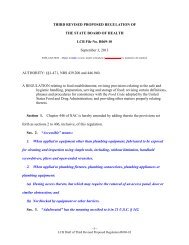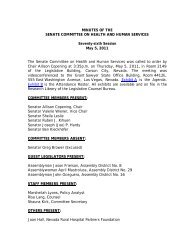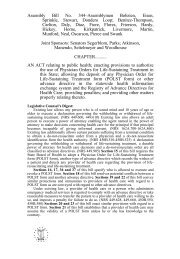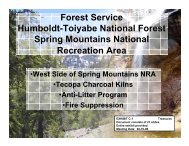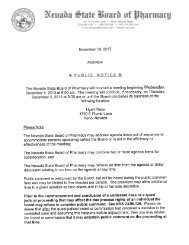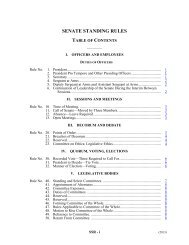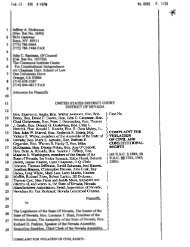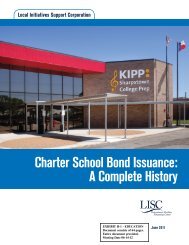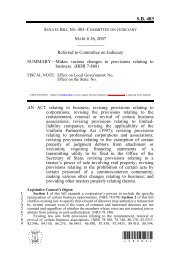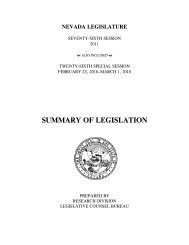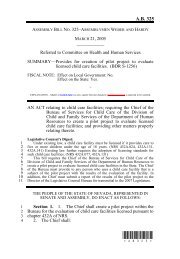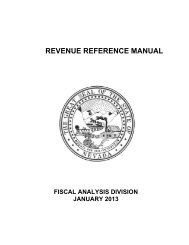Nevada Pre-Kindergarten Standards
Nevada Pre-Kindergarten Standards
Nevada Pre-Kindergarten Standards
Create successful ePaper yourself
Turn your PDF publications into a flip-book with our unique Google optimized e-Paper software.
SOCIAL STUDIES<br />
HISTORY 1.0 People, Cultures, and Civilizations – Students understand the development, characteristics, and interaction of people, cultures, societies,<br />
religion, and ideas.<br />
HISTORY 2.0 Nation Building and Development – Students understand the people, events, ideas, and conflicts that lead to the evolution of nations, empires,<br />
distinctive cultures, and political and economic ideas.<br />
HISTORY 3.0 Social Responsibility & Change – Students understand how social ideas and individual action lead to social, political, economic, and<br />
technological change.<br />
GEOGRAPHY 5.0 The World in Spatial Terms – Students use maps, globes, and other geographic tools and technologies to locate and extrapolate information<br />
about people, places, and environments.<br />
GEOGRAPHY 6.0 Places & Regions – Students understand the physical and human features of places and use this information to define and study regions and<br />
their patterns of change.<br />
GEOGRAPHY 7.0 Human Systems – Students understand how economic, political, and cultural processes interact to shape patterns of human migration and<br />
settlement, influence and interdependence, and conflict and cooperation.<br />
GEOGRAPHY 8.0 Environment and Society – Students understand effects of interactions between human and physical systems and the changes in use,<br />
distribution, and importance of resources.<br />
ECONOMICS 9.0 The Market Economy – Students will understand how scarcity and incentives affect choices, how markets work, why markets form, how supply<br />
and demand interact to determine the market price, and how changes in prices act as economic signals to coordinate trade.<br />
ECONOMICS 10.0 The U.S. Economy As A Whole – Students will identify indicators used to measure economic performance, understand key aspects of how the<br />
economy acts as a system, and understand the roles of money, interest rates, savers, and borrowers, financial institutions, and the central bank in our economy.<br />
ECONOMICS 11.0 The Dynamic Economy – Students will identify the causes of economic change, explain how the U.S. economic system responds to those<br />
changes; and explain how other economic systems respond to change.<br />
CIVICS 13.0 Citizenship and the Law – Students know why society needs rules, laws, and government and understand the roles, rights, and responsibilities<br />
of citizens.<br />
CIVICS 16.0 Global Relations – Students explain the different political systems in the world and how those systems relate to the United States and its citizens.<br />
SOCIAL– EMOTIONAL DEVELOPMENT<br />
1.0: Self-Confidence Students will participate in activities that foster independence, self-expression, and persistence.<br />
2.0: Self-Direction Students will demonstrate self-direction by attaining skills in self-management, self-help, and routines.<br />
3.0: Identification and Expression Feelings. Students will identify and express feelings.<br />
4.0: Interactions With Other Children and Adults - Students will develop positive interaction skills with other children and adults.<br />
5.0: Pro-Social Behaviors: Students will demonstrate positive social behaviors in play and group settings.<br />
6.0: Attending and Focusing Skills: Students will demonstrate attending and focusing skills.<br />
MUSIC<br />
1.0 Singing - Students sing a varied repertoire of music alone and with others.<br />
2.0 Playing Instruments - Students perform a varied repertoire of music on instruments alone and with others.<br />
3.0 Improvisation - Students improvise melodies, variations, and accompaniments.<br />
4.0 Writing - Students compose and arrange music within specified guidelines.<br />
5.0 Reading - Students read and notate music.<br />
6.0 Listening - Students listen to, analyze, and describe music.<br />
7.0 Evaluation - Students evaluate music and music performances.<br />
8.0 Application to Life - Students demonstrate relationships between music, the other arts, and disciplines outside the arts.<br />
9.0 Cultural and Historical Connections - Students demonstrate knowledge of the historical periods and cultural diversity of music.<br />
10.0 Cross- Curricular - Students demonstrate an understanding of movement through skills, techniques<br />
VISUAL ARTS<br />
1.0 Students know and apply visual arts media, techniques, and processes.<br />
2.0 Students use knowledge of visual characteristics, purposes, and functions.<br />
3.0 Students choose, apply, and evaluate a range of subject matter, symbols, and ideas.<br />
80



